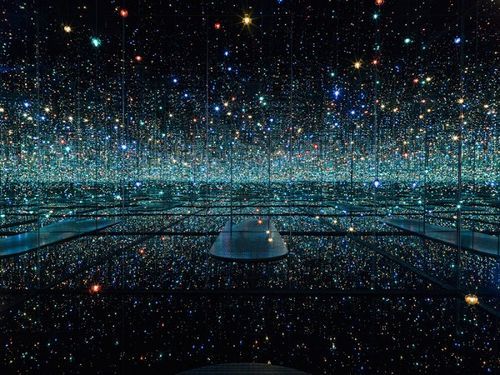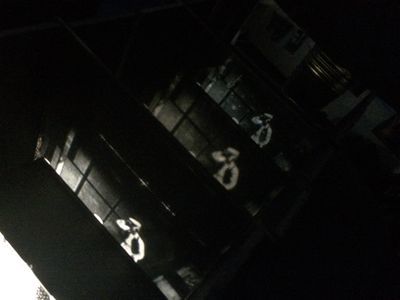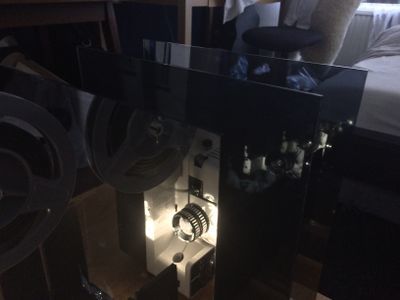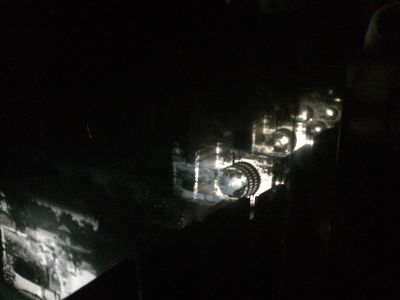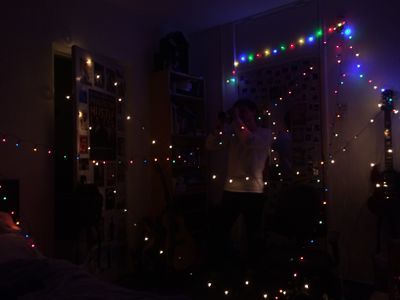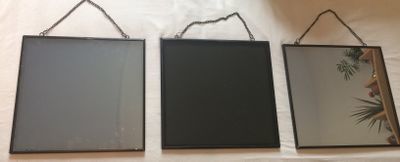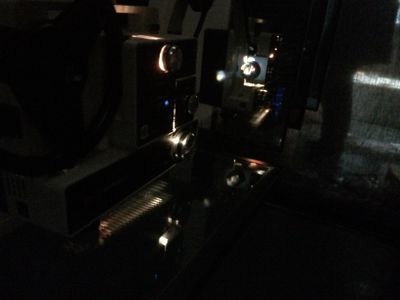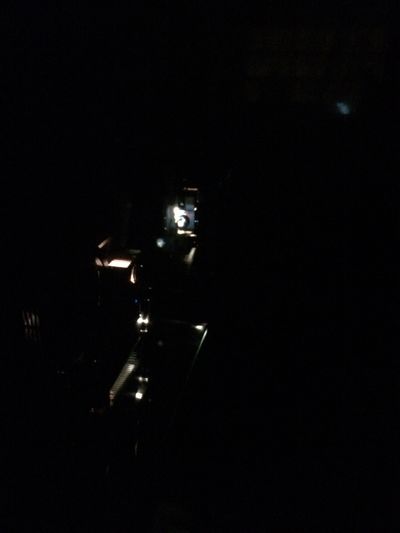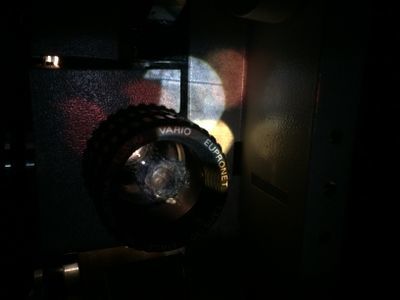Difference between revisions of "Final Research"
LarsNoback (talk | contribs) |
LarsNoback (talk | contribs) |
||
| (One intermediate revision by the same user not shown) | |||
| Line 22: | Line 22: | ||
Film, has, and always will be connected to technology. As a filmmaker I think it’s very important to always be aware of not just the developments in its technology, but also to be able to look back at where it came from. In other words, always be aware of the context of the medium you’re working in. | Film, has, and always will be connected to technology. As a filmmaker I think it’s very important to always be aware of not just the developments in its technology, but also to be able to look back at where it came from. In other words, always be aware of the context of the medium you’re working in. | ||
| − | ==Experiments | + | ==Experiments, Approach & Final Project== |
Working on several projects within the theme of electromagnetic radiation, what I thought was the most interesting is how through the creative use of different technologies, you’re capable of visualizing a spectrum that is invisible to the human eye. | Working on several projects within the theme of electromagnetic radiation, what I thought was the most interesting is how through the creative use of different technologies, you’re capable of visualizing a spectrum that is invisible to the human eye. | ||
| Line 64: | Line 64: | ||
[[file:Project mirror 5.JPG|400px]] | [[file:Project mirror 5.JPG|400px]] | ||
| + | |||
| + | |||
| + | [[file:Lmirrors 1.JPG|400px]] | ||
| + | |||
| + | |||
| + | [[file:Lmirrors 2.JPG|400px]] | ||
| + | |||
| + | |||
I wanted to make my own analogue film and project it on the mirrors, so I had to find a projector, camera, film and a place to develop it. I could either try to develop the film myself, but I decided not to do that, because the film is expensive and I didn’t want to ruin it, plus we don’t have the tools for it at the academy. | I wanted to make my own analogue film and project it on the mirrors, so I had to find a projector, camera, film and a place to develop it. I could either try to develop the film myself, but I decided not to do that, because the film is expensive and I didn’t want to ruin it, plus we don’t have the tools for it at the academy. | ||
| Line 79: | Line 87: | ||
I tested what I wanted to film on my digital camera first, with a similar lens, as close to the same settings as I could get. Then, to be sure, I used an external light meter to see what readings it would give. | I tested what I wanted to film on my digital camera first, with a similar lens, as close to the same settings as I could get. Then, to be sure, I used an external light meter to see what readings it would give. | ||
During filming I moved around a bit and changed perspectives, but I had already decided to pause the film. But by filming different angles I could pick the best moment, also because I can only see what I filmed when its developed about a week later. In the end I picked a moment where multiple lights came together in the centre of the image. | During filming I moved around a bit and changed perspectives, but I had already decided to pause the film. But by filming different angles I could pick the best moment, also because I can only see what I filmed when its developed about a week later. In the end I picked a moment where multiple lights came together in the centre of the image. | ||
| + | |||
| + | [[file:Lightsfilm.JPG|400px]] | ||
| + | |||
Up until now I had only used cardboards to hold up my mirrors. What I really wanted is for the mirrors to be hanging from the ceiling, as if they are floating in the air. So you could easily move around, underneath and perhaps above them. I found these iron frames that were the exact same size as the mirrors. I sawed out the back and painted them black. This way it’s almost as if they aren’t there in a dark room. | Up until now I had only used cardboards to hold up my mirrors. What I really wanted is for the mirrors to be hanging from the ceiling, as if they are floating in the air. So you could easily move around, underneath and perhaps above them. I found these iron frames that were the exact same size as the mirrors. I sawed out the back and painted them black. This way it’s almost as if they aren’t there in a dark room. | ||
| + | |||
| + | [[file:Frames.jpg|400px]] | ||
I also had to find something to put my projector on, which also needed to be the perfect height. I found the perfect height to be somewhere you could easily look over the projector and the mirrors, where squatting down would make you able to look at it at eye level or potentially look underneath it. At first I was thinking about making something simple from wood and then painting it black. But the projector also lights up the surface it’s on, which got me thinking about putting it on glass. I started looking around for furniture with glass surfaces. I found one that was perfect, a laptop stand that only had vertical stands on one end, so it looks from one side like its floating. By placing the projector on this in a dark enough space, you can only see the glass surface and the reflection of the projector in it. | I also had to find something to put my projector on, which also needed to be the perfect height. I found the perfect height to be somewhere you could easily look over the projector and the mirrors, where squatting down would make you able to look at it at eye level or potentially look underneath it. At first I was thinking about making something simple from wood and then painting it black. But the projector also lights up the surface it’s on, which got me thinking about putting it on glass. I started looking around for furniture with glass surfaces. I found one that was perfect, a laptop stand that only had vertical stands on one end, so it looks from one side like its floating. By placing the projector on this in a dark enough space, you can only see the glass surface and the reflection of the projector in it. | ||
| + | |||
| + | |||
| + | [[file:Table1.JPG|400px]] | ||
| + | |||
| + | |||
| + | [[file:Finalmirror1.JPG|400px]] | ||
| + | |||
| + | [[file:Final 2.JPG|400px]] | ||
| + | |||
| + | [[file:Close.JPG|400px]] | ||
| + | |||
| + | |||
So ideally this project would be exhibited in a completely dark room, without anything else in it. There would be no other light or sound sources. | So ideally this project would be exhibited in a completely dark room, without anything else in it. There would be no other light or sound sources. | ||
Latest revision as of 21:53, 24 January 2017
Contents
My practice and its relationship with craft and technology
I am a creator. I enjoy putting effort in making things that didn’t exist before.
I am a filmmaker. In my work I use moving images that I’ve captured with my camera. To me, film is a very powerful tool to communicate. Whenever I make something it usually ends up being either a video, or something that contains a video. I enjoy looking at the world through a camera because I can use it to show the world in my own subjective way, while at the same time being relatively honest to the ‘truth’, because you can only capture what already exists. I specifically call myself a filmmaker, before anything else like artist or designer.
I am a director. I direct my own work. Whether I work alone or in a group, I’m always involved during the whole process of creating, from concept to development.
I am a person. Everything I create comes from within. The most important aspect of my craft is being able to express my vision. I am a filmmaker because film is the best medium for me to do that. I use film as a tool to show my view, the things that nobody else sees. I’m a conceptual thinker. What I create usually makes sense to me. I start out with a particular interest towards a certain subject. I start researching and thinking, combining subjects, themes, thoughts, formats and ideas until there’s a point in my mind where everything fits and makes sense. This is also the point of no return, when this concept exists in my mind I have to realize it.
It’s important to me to be aware of the historical context of the medium I practice. You can never make anything that’s relevant if you cannot place it in the context of your craft. You have to know the historical process your medium has gone through in order to make relevant work within that practice. Everything that gets created today is the result of everything that has been created before that.
I think it’s interesting that when a new medium comes into the world, people tend to describe it with things that already existed before. For example film was described as moving photographs, like it was supposed to replace photography altogether. Instead of it being two different mediums. If you look at some developments in film, people have the same reactions. For example, virtual reality supposedly is the next big thing. You know, why watch a film if you can be part of it? But what if film and virtual reality are so much different that neither can really ‘replace’ the other. What I don’t appreciate is progress for the sake of progress. Or progress for the sake of making money. What I personally enjoy about watching films is that you don’t have to make any choices. Which is also the nice thing about making a film, you get to make choices about what you want to show. There are so many decisions to make in film that are completely different in virtual reality. For example camera angles, lenses, focus, camera movement and editing. I watch films as a passive viewer, subjecting myself to the choices of the filmmaker. Virtual reality expects a much more active viewer, having to grab their attention in the right directions in order to tell the right story. Virtual reality needs engagement in order for it to work, which is a completely different attitude from its audience. If you can get your vision across using virtual reality, then use it. But if it’s just a gimmick that provides a fun experience, it’s not for me.
I’m not saying that virtual reality isn’t something exciting. It comes with many new possibilities and experiences, but it’s just something else entirely. So this makes it frustrating for me when people talk about new technologies like it’s just going to revolutionize the world and change everything we know about film. I really enjoy films and I personally don’t feel like anything needs to be changed or developed or revolutionized within this specific form. The technology, to me, is almost at it’s highest capacity. Cameras might get slightly better each year, but it’s not going to drastically change the experience for me.
But film is still a business, so going to movies in the theater has to be more attractive than streaming movies at home. So they come up with 3D movies and moving chairs. What I don’t appreciate is progress for the sake of progress. Or progress for the sake of making money. Film is an art form to me, so I don’t like to be associated with capitalistic systems. The future is exciting and I would love to try out and explore these new technologies, but I think it’s always important to know what you’re dealing with. To know where your craft came from and where it’ going. The best works I find are often self reflective to the medium it’s using. Referring to the medium itself, in obvious and less obvious ways. Looking at the future also makes me stop and look back at the past. The way I display my work is almost always digital. Even the physical things I make end up as a digital documentation. However, I’m starting to feel more drawn to the physical features of film, like in celluloid film or VHS, but also the physical elements of the way we watch film. Digital film is the result of each of its successors. It’s a historic process, but the physical elements still echo through in the digital realm. Using older technologies can create very strong images. Not just for nostalgic reasons, but also because using outdated technologies is very unexpected to many people and really makes them wonder why you would use them. It focuses their attention towards the specific characteristics of the tool compared to newer technologies and the value of those differences.
Film, has, and always will be connected to technology. As a filmmaker I think it’s very important to always be aware of not just the developments in its technology, but also to be able to look back at where it came from. In other words, always be aware of the context of the medium you’re working in.
Experiments, Approach & Final Project
Working on several projects within the theme of electromagnetic radiation, what I thought was the most interesting is how through the creative use of different technologies, you’re capable of visualizing a spectrum that is invisible to the human eye. For example, at the beginning of the minor, we used a simple camera-hack to let it capture near-infrared images. By removing the visible spectrum you’re left with an image that is recognizable, yet very uncanny.
I regularly work with digital cameras. With that, I also capture electromagnetic radiation, but the images aren’t as uncanny as infrared-images because we as humans can already see this type of radiation with our own eyes. The technology of cameras isn’t very exciting to most people, because we are used to it. It’s very accessible, every smartphone lets you capture images. It got me thinking that, for me as a filmmaker, the only significant difference between capturing visible light and infrared or other types of radiation, is that we can already see it.
Then I thought of how digital film and analogue film both capture visible light, yet they do it in a completely different way. Where digital film converts light into pixels, analogue film becomes physical. I have always been fascinated by analogue films. I think the look and feel of watching an actual physical film that’s projected is very powerful, for nostalgic reasons because it’s been a dying medium for a while, but also because of the unique qualities that feel so much more special than digital video. Besides, I think it is important for me as a filmmaker to be familiar with the ‘roots’ of my medium, as it gives you technological insights that are still important, even for digital filmmaking and it makes you more knowledgable within the, field which can make your work more relevant.
Besides knowing the past of your medium, I also think it can be very important and useful to be aware of the future. More often now, I see how people are starting to get interested in virtual reality. Me personally, I also feel this ambition to work with this technolog. What’s most exciting to me, is that it’s still young enough for you to have a much higher potential to do something unique and revolutionary with it than with an older and more developed medium.
I’ve been talking to people about virtual reality and what I might want to do with it. At some point I was talking to someone who was convinced that virtual reality is the future. Not just of film, he thought instead of screens, we would have our virtual reality glasses on all the time. He had a very dystopian vision of the future where everyone would stay in their rooms all the time. Even though I don’t believe that this will ever happen, the thought is still very sad. I enjoy making videos or films and I enjoy watching them. I can also enjoy virtual reality experiences, but I don’t enjoy them in the same way at all. I watch films in a very passive way, but virtual reality is often a very active activity. I appreciate editing, framing, focal length, depth of field. Things that don’t exist in virtual reality. Luckily it seems like most people feel the same way about this. It’s still interesting to me though that people generally have the tendency to treat new media as transcending versions of older media. People used to explain film as moving photographs, but luckily photography still exists and no-one treats it as outdated.
Looking at the history of film though, something else has happened. If you listen to the people who still shoot on analogue film, they treat it as a different medium than digital film. Saying that they would quit filmmaking if they can’t get their film developed anymore. I never understood this as much as I do after having shot on analogue film. It obviously looks different but the thing that makes it truly different is the way of working. Shooting on film gives you a completely different attitude. Having to plan everything very carefully. There is much more on the line because it takes a lot more time and money to shoot something.
Once you start looking at analogue film as a different medium, it becomes very sad that people are rarely using it anymore. So I’m wondering what would have happened if people had always treated digital film as something new and different. Would more people still use analogue film today? How would it have evolved?
Once that got me thinking I thought about what something like virtual reality would look like if digital film didn’t exist at all. At first I thought about mimicking virtual reality. 360º videos are usually recorded with multiple cameras in a circle and the images are later stitched together to create a surrounding image. The same effect could be achieved by using multiple Super 8 cameras and then projecting them at the same time in a circle. You could also project on a dome shaped mirror so the image would get distorted in space and surround the viewer.
However, I realized that trying to mimic something that already exist, something that came from digital video, could never convey what I was trying to tell. Because trying to be the same is the opposite of what I want. I needed to find the essence of what I think is most important about the potential of virtual reality. I’ve tried some virtual reality videos and games and it was almost always a disappointment because I became very aware of how unrealistic it was. I’m very aware of the glasses and I’m trying not to bump into anything. One time though I got the opportunity to play a game on one of the newer models, one that would also track your position within the room. The glasses were much more comfortable and the depth perception was very realistic. This made it a very fun experience, because I wasn’t as much distracted by the technology. They still had to setup four sensors that track your position and you’re also attached to a computer with a long cable. I always learned that a film is the most enjoyable and realistic when the technology isn’t distracting. For example if the camera movement is very shaky, you’re distracted and you become aware that there is a camera and someone who’s operating it. If you can see something is obviously recorded in front of a green-screen, you’re distracted. I think the same thing applies to the technology of virtual reality. So I knew I wanted to create an experience where you don’t need special glasses, it had to be something you can experience without needing special tools. I can personally get very excited over the fact that I can actually see depth with my eyes and physically move through it, which to most people probably seems very ordinary.
I was thinking about ways to create the illusion of physical space, that you can experience with your own eyes. I started looking at images of infinity mirrors and I found this image of a room that is completely covered in mirrors, and has hanging lights all through it, which creates a seemingly infinite space. The thought of being in this room gives me a childlike happiness.
I wondered if I could create the same infinity room idea but with a projected image, but I knew that projecting on a mirror just creates a blurry image on the glass itself. I thought that it might work if you project through a two-way mirror, but then I found this video that shows you can actually project the image on it. After seeing this I ordered some of these two-way mirrors to experiment with it. In the meantime I tried achieving the same effect by applying reflective window film on a piece of glass. In the end this worked even better, because the image was much clearer if you project of the film. The two-way mirror that I got let through more light than it reflected back.
I took two pieces of glass with reflective film on it to try projecting on it and it worked, the image starts repeating itself. I built a very simple (crappy) construction out of cardboard to hold the glass in place and started experimenting with different distances between the glass and the projector. I realized that the effect was much stronger when the room it is in is completely dark. If there is too much light around, you look straight through the mirror.
I wanted to make my own analogue film and project it on the mirrors, so I had to find a projector, camera, film and a place to develop it. I could either try to develop the film myself, but I decided not to do that, because the film is expensive and I didn’t want to ruin it, plus we don’t have the tools for it at the academy. There are two people who commercially develop 8mm film in this country, only one of them actually stopped his business during the time I was looking into it. So there was one place in the entire country where I could buy the film and get it developed. Speaking to the owner of this store confirmed my thoughts about the medium dying. He told me that his busiest moment of the year was during Christmas because people want to watch their old films during the holidays. The rest of the year, he doesn’t have a lot of customers, and almost no young people. He was very frustrated that students don’t get taught how to work with analogue film, because he felt it was the first thing you should learn, the base of filmmaking.
The projectors and cameras aren’t really made anymore so I had to find used ones. I could still find many of them online, but hardly any of them had been taken care of properly. I found someone who buys, fixes and resells them for a decent price, so I bought one projector from him. One of the hard parts of making an installation with an analogue film, is that eventually the film runs out and it falls off the spool. The longest film I could buy was 15 meters, which would run for about three minutes at a normal frame rate. So after three minutes I would have to re-loop the film, rewind it and play it again. I found out that some projectors could play in slower frame rates. So I bought the one that could play it the slowest, which would extend the time to about 20 minutes. This projector could also pause the film so I could also decide to do that.
The amount of work that went into finding and getting all the proper tools and people really became an experience on its own. It also proved again that analogue film really is dying, especially Super 8 film.
I was having some trouble figuring out what I needed to film. I wanted the project to be more about the materials that I used and the effect it would achieve, than about the subject that is on the film. I also had to decide between color or black and white. I thought that black and white would focus more on the effect of the mirrors and would tell a more essential story about light, but I decided on color because it has a more recognizable analogue look which would look much more distinctive and also more beautiful. This turned out to be a good decision because there weren’t enough people who wanted to get black and white film developed for it to be ready on time. This also shows that in a ‘busy period’ there still aren’t that many submissions. Because I was using color film, I wanted to take advantage of those qualities by choosing different colors that would look good on film. I still felt like the subject of the film wasn’t truly important. The effect would work better in high contrast, preferably with small light sources. I thought about going through the city streets and filming lights at night, but I needed a controlled environment because the camera is much more complicated when it comes to lighting, especially in low light situations. The camera I used has a built in light meter, but unfortunately the batteries aren’t made anymore. This again proves how people really don’t care about this technology anymore. In the end I decided to get a bunch of different color Christmas lights to film its reflection in the window when it’s out of focus. In this way the subject isn’t very meaningful or recognizable, but it’s still obviously a light source and the way it looks when it’s out of focus is still obviously due to how the camera works. I tested what I wanted to film on my digital camera first, with a similar lens, as close to the same settings as I could get. Then, to be sure, I used an external light meter to see what readings it would give. During filming I moved around a bit and changed perspectives, but I had already decided to pause the film. But by filming different angles I could pick the best moment, also because I can only see what I filmed when its developed about a week later. In the end I picked a moment where multiple lights came together in the centre of the image.
Up until now I had only used cardboards to hold up my mirrors. What I really wanted is for the mirrors to be hanging from the ceiling, as if they are floating in the air. So you could easily move around, underneath and perhaps above them. I found these iron frames that were the exact same size as the mirrors. I sawed out the back and painted them black. This way it’s almost as if they aren’t there in a dark room.
I also had to find something to put my projector on, which also needed to be the perfect height. I found the perfect height to be somewhere you could easily look over the projector and the mirrors, where squatting down would make you able to look at it at eye level or potentially look underneath it. At first I was thinking about making something simple from wood and then painting it black. But the projector also lights up the surface it’s on, which got me thinking about putting it on glass. I started looking around for furniture with glass surfaces. I found one that was perfect, a laptop stand that only had vertical stands on one end, so it looks from one side like its floating. By placing the projector on this in a dark enough space, you can only see the glass surface and the reflection of the projector in it.
So ideally this project would be exhibited in a completely dark room, without anything else in it. There would be no other light or sound sources. During our exhibition, I was reminded that most people have forgotten that analogue film exists and most young people don’t really know what it is at all. I really enjoyed the exhibition ‘Celluloid’ at Eye filmmuseum in Amsterdam and I really like the idea that people go there just for film as an art form. It reaches a very specific audience. An audience that I couldn’t really get for my work in our group exhibition. There were almost no people that I spoke to that were personally already interested in analogue film. Which if you think about it is again very sad for film, because if a filmmuseum has an exhibition about the importance of sustaining analogue film, but the main audience it attracts is people who are already interested in this, then you don’t really gain that much. This did make it a little frustrating because most people who were looking at my work would at most say they think it was intriguing or pretty, but only few actually took the time to really look at it and think and talk about it. Fortunately there were also people, who didn’t really know anything about analogue film, but were very interested in it and talking about it. What would be really nice is if I could take the ideas of this project further to make something that is easier to understand for people who know nothing about the subject and where they don’t need much context from the exhibition place. Something more accessible to a bigger and less specific audience.
Research plan for graduation
I still feel like virtual reality is a very interesting terrain. I’m very attracted to the idea of a new medium that isn’t very developed yet. There’s a lot of room for people to take within the development of this field. It’s very hard to do something completely new as a filmmaker, but with virtual reality there are more opportunities.
I think it can be very funny to look at different applications of virtual reality. I saw an article some time ago about a school where their students learn to clean using a virtual reality application. This just makes me laugh because they’re using expensive to develop technology to teach students something, of which the conditions aren’t very hard to come by and I don’t feel like cleaning in a virtual surrounding isn’t at all the same thing as cleaning in real life. I feel like using virtual reality can become very powerful when the viewer/user gets to be in a virtual environment that is much more special compared to real life. You don’t want to use this technology just to pretend to be in a situation that you’re not, just because you can, especially if the environment isn’t hard to recreate in real life. You want to experience something that you can’t in real life. Otherwise it’s just weak, because you’ll know the real thing will be nothing like it.
Still I think it’s very funny to see what people come up with. I’m also trying to take pictures or save all the projects I find that I think are ridiculous. They could be interesting for my research, or maybe I’ll make something funny out of it.
I was looking into the subject out of body experiences when I was looking for a title for my project and I found this funny old website that had a video with a man talking about how he could leave his body when he was sleeping, in a fully conscious state where he could float around the real world. It just made me think about if you would want to make a film or perhaps documentary about this subject, virtual reality would be perfect for it. In that case you could let the viewer come closer to experiencing something that they could probably never do in real life. In that case the fact that you’re using the technology of virtual reality truly adds something unique to the film. Filming a documentary using virtual reality technology can also be an interesting challenge. I feel that working with analogue film really gave me a better understanding of what the medium really is and what it means to work with it. I haven’t truly made a virtual reality film though and I feel the need to at least really try it, before I can make my graduation work. I would really like to do some more research into the projects that exist today that use virtual reality. Once in a while you come across a project that really uses the technology well, but what I see the most is people wanting to try this new thing for the fun of it.
I also feel like I’m not done yet with analogue film. I only got to film once on 8mm, but I also have one more disk in my fridge. It was very exciting to me to film in this way. I’m not sure if I want to base my graduation project on this as well, but I would like to do more research on it.
I’ve also been thinking about taking the same inspirations and ideas about virtual reality from my project, but taking it into a more immersive and universal experience, maybe using a complete room or at least something that is surrounding to the viewer.
As I’m not completely sure about what I want to do in a concrete way, I’m just planning on focusing on researching projects and themes that already exist. Hopefully I’ll be able to see some virtual reality projects and check out what technology is available to me.
End statement
I’m happy that I finally decided to work with analogue film and I’m excited to work with it again in the future. I’m also excited to work more with virtual reality and whatever other technologies the future might bring. If there’s one thing I have learned, it’s that you should never judge technology based on its age. Going back in time doesn’t just have to be something nostalgic. I understand this feeling of wanting new gadgets, every once in a while I catch myself being drawn to something new. But I’m also using my old camera that runs tapes again. Many of these things from the past become retro instead of outdated, which I guess is a good thing. It means there’s still hope. Kodak announced last year that they’re making a new 8mm camera and they’re also bringing back their best selling color film. I’m hoping that people will respond to this and that it will become easier to buy and develop your own films.
